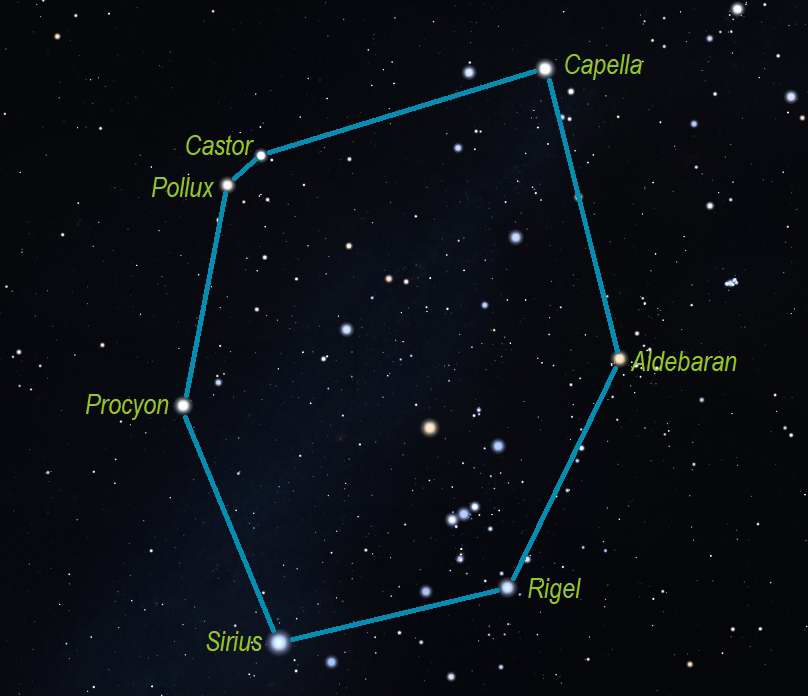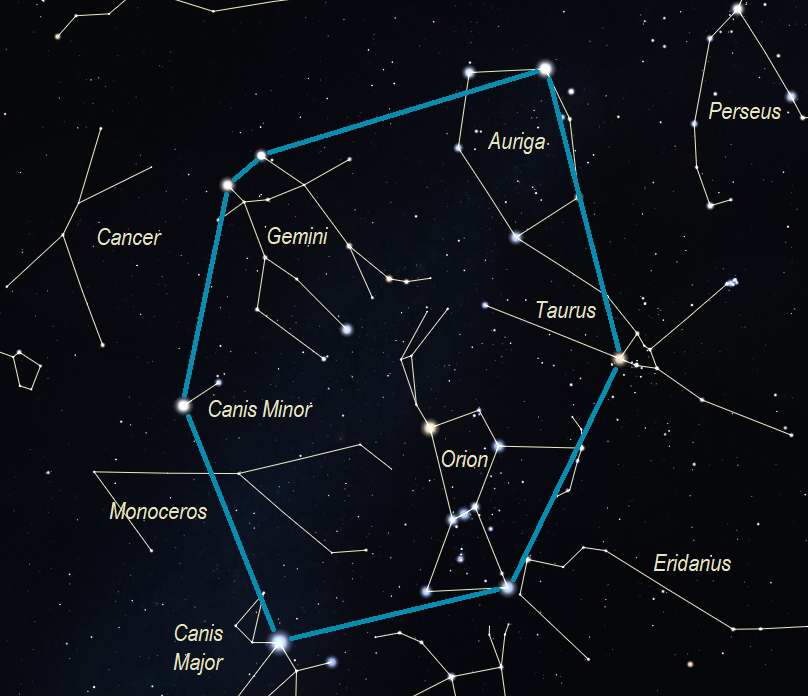Beginner's Guide
Naked-Eye Asterisms
Constellations vs Asterisms
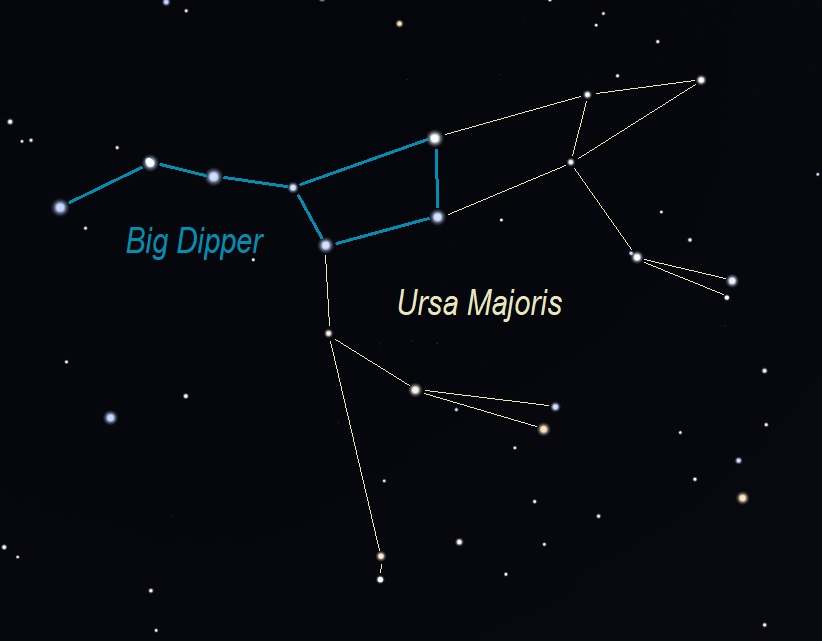 A constellation is an area of the sky which a group of stars forms an outline or pattern.
They can represent animals, mythological persons, creatures,
or an inanimate object.
The word constellation is from the Latin constellacio, which means a set of stars.
We officially recognize 88 constellations in the sky and there are set areas that have been defined which form their borders.
An asterism is very similar to a constellation. It is a popularly known pattern or group of stars which are visually obvious as are
the lines used to mentally connect them.
A constellation is an area of the sky which a group of stars forms an outline or pattern.
They can represent animals, mythological persons, creatures,
or an inanimate object.
The word constellation is from the Latin constellacio, which means a set of stars.
We officially recognize 88 constellations in the sky and there are set areas that have been defined which form their borders.
An asterism is very similar to a constellation. It is a popularly known pattern or group of stars which are visually obvious as are
the lines used to mentally connect them.
Easily the most well known asterism in the sky is the Big Dipper. What makes the Big Dipper an asterism is that it is actually part of the larger constellation Ursa Majoris.
 Though almost all the popularly recognized asterisms are just part of a constellation, they can span multiple constellations. The most famous of
them is the Summer Triangle which is composed of Vega (in the constellation Lyra), Deneb (Cygnus), and Altair (Aquila). Though it may not seem so obvious looking
at the sky diagram at the left, the stars appear brighter in the sky. On summer nights if you are viewing after sundown, the 3 stars of the Summer Triangle will
be among the first you'll see.
Though almost all the popularly recognized asterisms are just part of a constellation, they can span multiple constellations. The most famous of
them is the Summer Triangle which is composed of Vega (in the constellation Lyra), Deneb (Cygnus), and Altair (Aquila). Though it may not seem so obvious looking
at the sky diagram at the left, the stars appear brighter in the sky. On summer nights if you are viewing after sundown, the 3 stars of the Summer Triangle will
be among the first you'll see.
Another type of asterism is where the asterism is basically the constellation. An example is the Little Dipper which is practically all the stars of the Ursa Minor (Little Bear).
Naked-Eye Asterism Examples
By their very nature asterisms are easier to spot than the constellations. As such they can help you navigate the night sky and help you spot and help learn the constellations. Below we present 26 of the more commonly recognized asterisms. It is not necessary that you really learn any of these, but after you've looked into the sky and seen some patterns you think stand out, you will want to refer to them. And keep in mind you may even see in the sky asterisms that are not widely recognized!
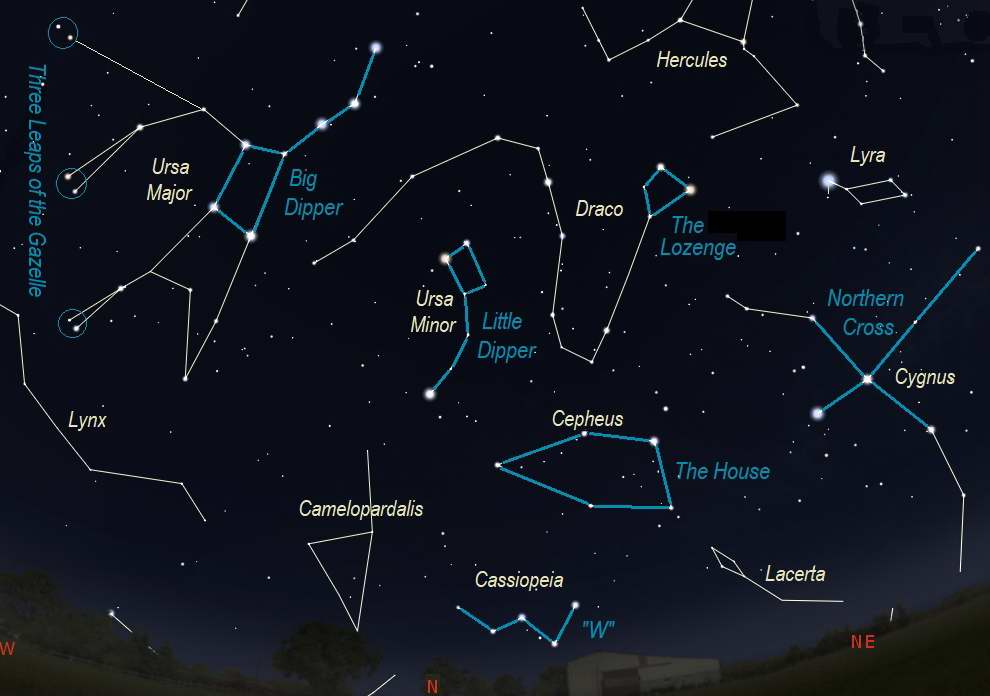 The diagram basically shows the circumpolar area of the sky but includes the constellation Cygnus (which contains the Northern Cross) and Lyra.
The diagram basically shows the circumpolar area of the sky but includes the constellation Cygnus (which contains the Northern Cross) and Lyra.
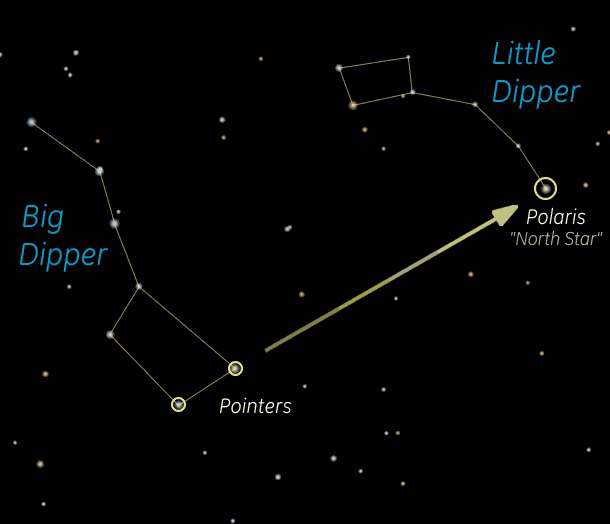 Big Dipper This is easily the most well known asterism seen in the northern hemisphere. It is known as the Plough (plow) in the UK
and Ireland. It is part of Ursa Major (the Big Bear). What makes the Big Dipper so significant is that it is circumpolar and the first two stars of the "pan"
(α and β UMa) are known as "The Pointer Stars" because they basically point to the Polaris (the North Star).
Big Dipper This is easily the most well known asterism seen in the northern hemisphere. It is known as the Plough (plow) in the UK
and Ireland. It is part of Ursa Major (the Big Bear). What makes the Big Dipper so significant is that it is circumpolar and the first two stars of the "pan"
(α and β UMa) are known as "The Pointer Stars" because they basically point to the Polaris (the North Star).
Three Leaps of the Gazelle This is another asterism contained within Ursa Major. This asterism is comprised of three pairs of stars in alignment and are the paws of Ursa Major. The story is that Leo the Lion startled the gazelle, who in turn dashed off across a great celestial pond, leaving a pair of stars marking each of the three leaps.
Little Dipper It's called the Little Dipper to distinguish it from the dipper in Ursa Major. This asterism is basically the whole constellation of Ursa Minor, the little bear. But be warned though it's not too difficult to find because it contains the North Star (Polaris), with the exception of 3 stars, it is fairly faint.
"W" This is basically the constellation of Cassiopeia. In the position we're showing it you can see that it is a W. However, when the constellation is above the North Star it looks like an M. So it can named either way, but it is almost always referred to as a W.
The Lozenge These are the 4 stars of the head of the constellation Draco. A lozenge is a diamond or rhombus shape.
Northern Cross This asterism follows closely with the constellation Cygnus (The Swan). It is called "Northern" because there is a constellation in the southern hemisphere called Crux, whose major stars form the Southern Cross which is depicted on the flags of Australia and New Zealand.
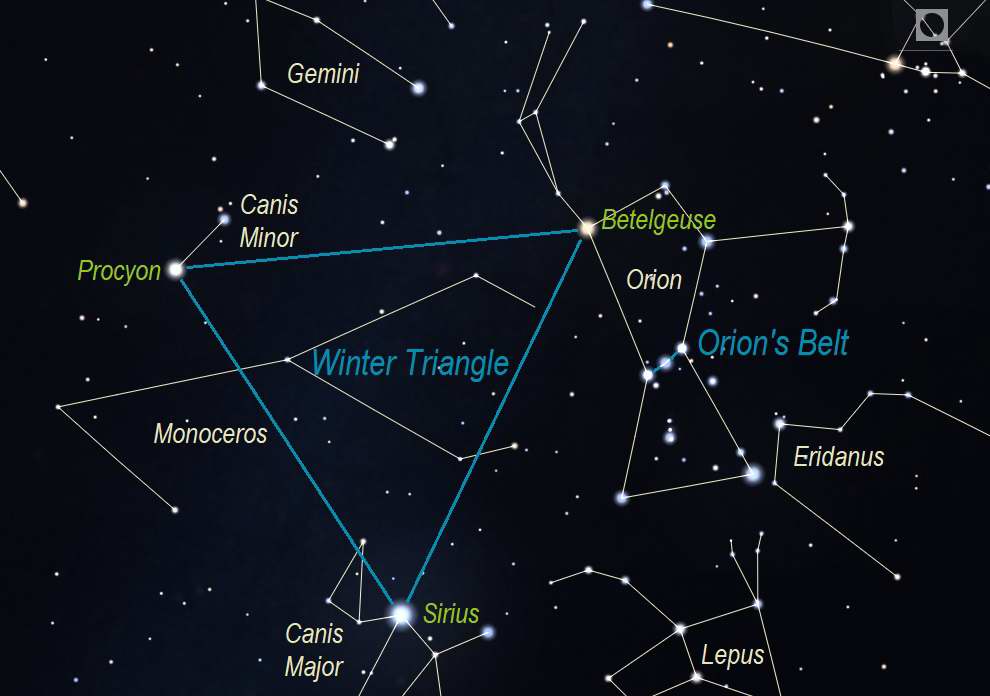 The diagram shows the southern sky as seen in winter during the early evening. The sky is dominated by the constellation Orion and many fairly
bright stars.
The diagram shows the southern sky as seen in winter during the early evening. The sky is dominated by the constellation Orion and many fairly
bright stars.
Orion's Belt The three stars of Orion's Belt are easily the most recognizable asterism in the entire sky. And the constellation Orion is considered the brightest in the sky.
Winter Triangle The three stars that comprise the Winter Triangle are Sirius (in Canis Major), Procyon (Canis Minor), and Betelgeuse (Orion).
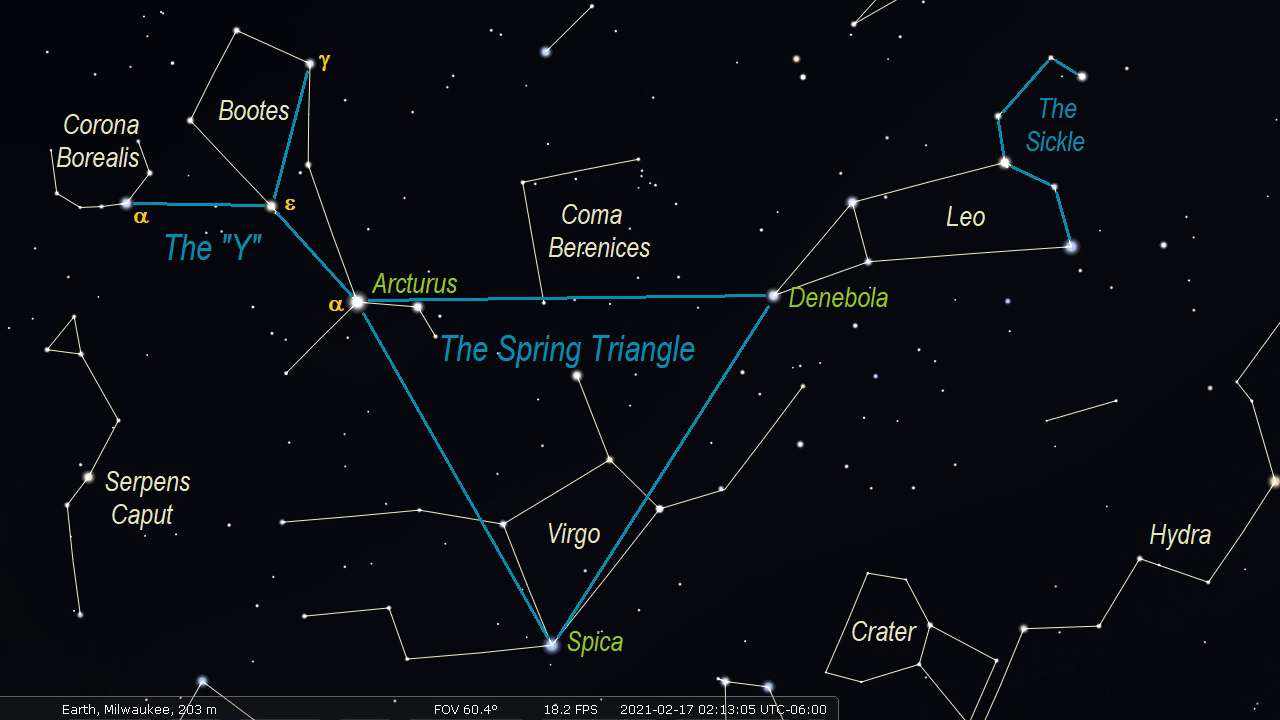 The diagram shows the southern sky as seen in spring during the early
evening.
The diagram shows the southern sky as seen in spring during the early
evening.
Spring Triangle The three stars that comprise the Spring Triangle are Arcturus (in Boötes), Denebola (Leo), and Spica (Virgo).
The "Y" This asterism is comprised of the central star ε Boötes, Arcturus (α Boötes), γ Boötes, and α Corona Borealis.
The Sickle This asterism is probably the most recognizable one in the spring sky behind the Big Dipper. Though it also looks like a backwards question mark, it is rarely referred to that way.
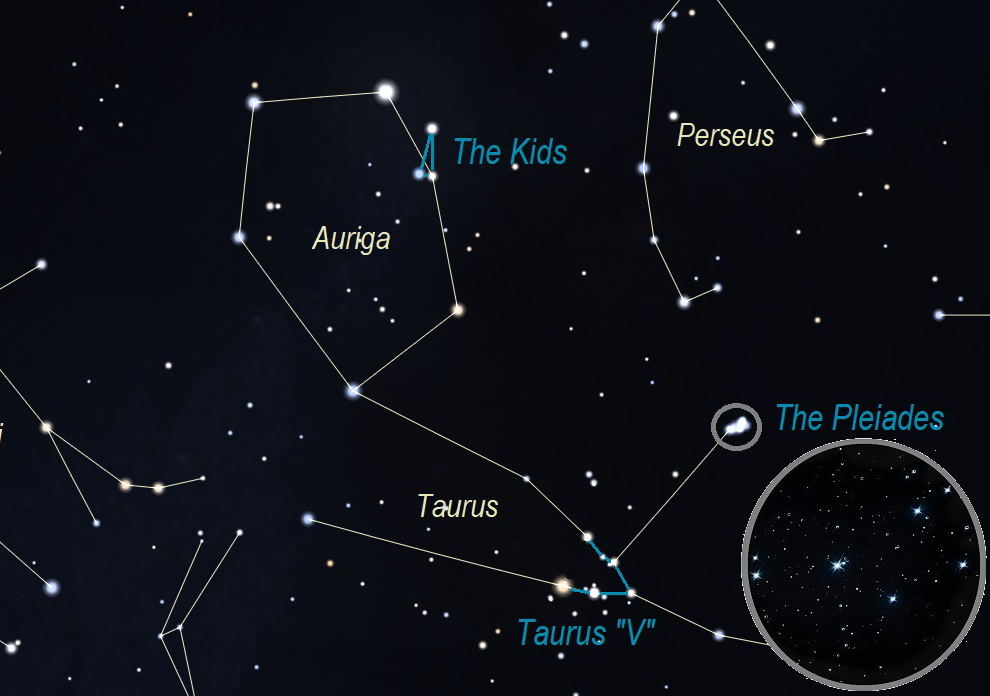 The diagram shows the high southern sky as seen in winter during the early
evening.
The diagram shows the high southern sky as seen in winter during the early
evening.
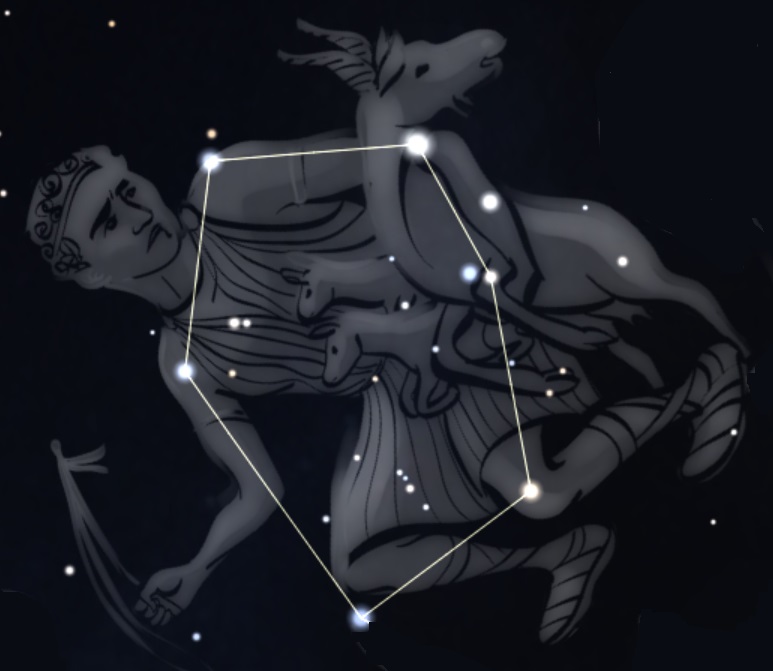 The
Kids This asterism is in the constellation Auriga. This
small triangle of stars is called The Kids because the graphic
representation of of constellation (seen at the right as depicted in
Stellarium) shows Auriga holding a goat and kids.
The
Kids This asterism is in the constellation Auriga. This
small triangle of stars is called The Kids because the graphic
representation of of constellation (seen at the right as depicted in
Stellarium) shows Auriga holding a goat and kids.
Taurus "V" This asterism is made up stars in the head of Taurus. Contained within this figure is an open star cluster known as the Hyades which is a nice binocular object. The bright star of this group, Aldebaran, is not technically a part of that cluster.
The Pleiades This asterism is also known as the Seven Sisters is actually a cluster of 9 stars as it includes the 2 parents. The Pleiades is both a naked-eye and binocular asterism as it is so condensed.
 The diagram shows the low southern sky just above the horizon as seen in the early summer sky.
The diagram shows the low southern sky just above the horizon as seen in the early summer sky.
Teapot This asterism is formed from the brightest stars in Sagittarius.
Teaspoon Not an especially striking asterism, but it goes along with the teapot.
Fish Hook This asterism is comprised of most of the bright stars of the constellation Scorpius.
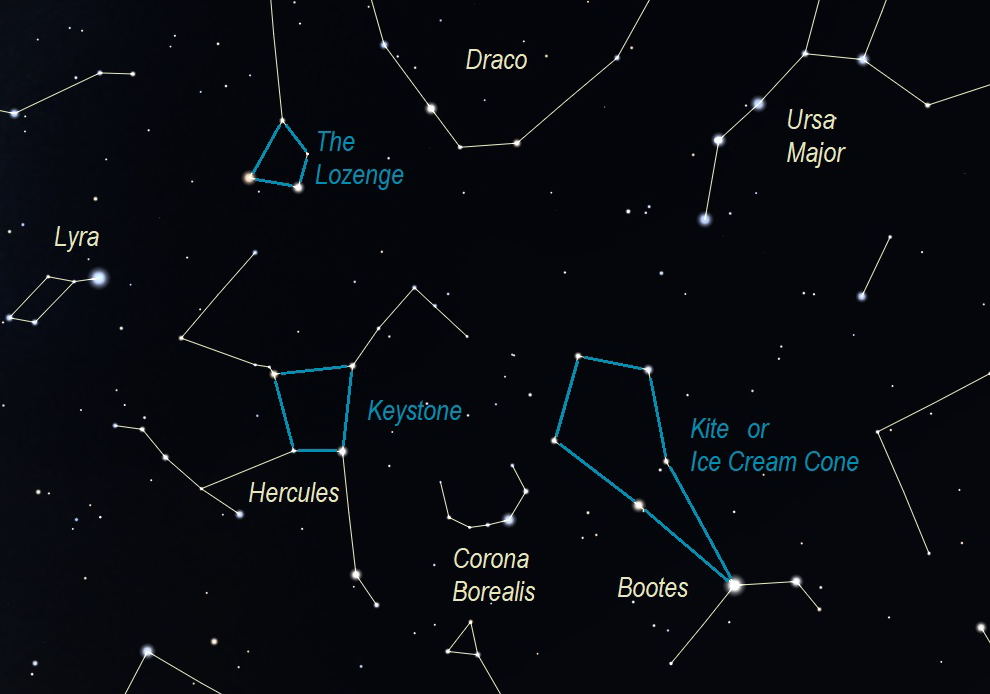 The diagram shows the southern sky as seen in spring during the early evening.
The diagram shows the southern sky as seen in spring during the early evening.
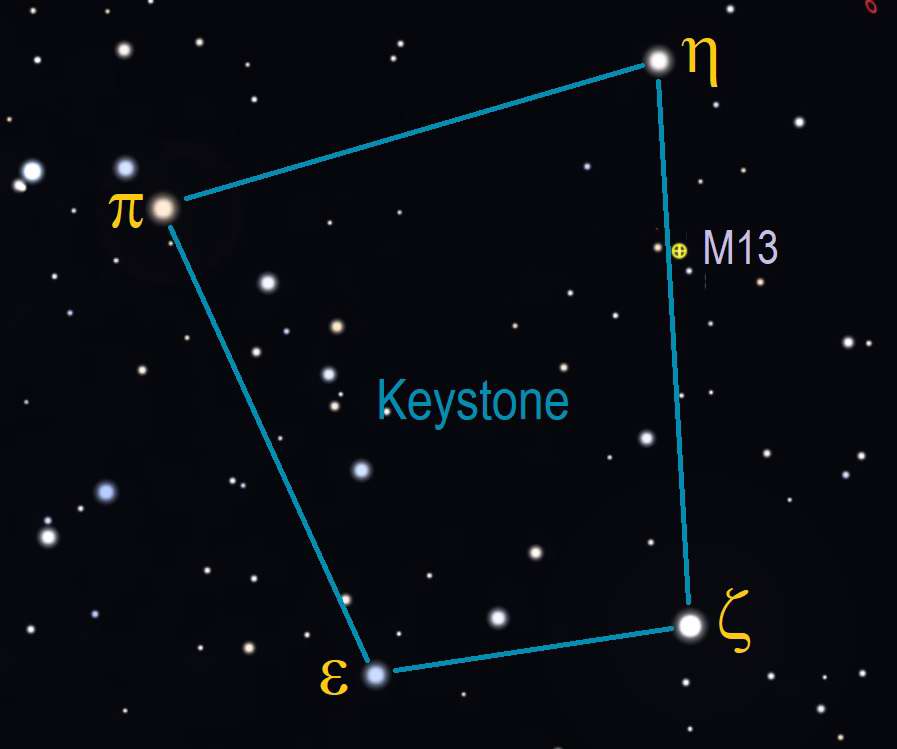 Keystone The Keystone is an asterism
formed by four relatively bright stars in the Hercules: π, η, ζ, and ε Herculis.
This trapezoid-shaped pattern makes it easy for observers to identify the constellation Hercules and also to find M13,
the brightest globular cluster in the northern sky.
Keystone The Keystone is an asterism
formed by four relatively bright stars in the Hercules: π, η, ζ, and ε Herculis.
This trapezoid-shaped pattern makes it easy for observers to identify the constellation Hercules and also to find M13,
the brightest globular cluster in the northern sky.
Kite or Ice Cream Cone Formed within the constellation of Boötes, this asterism is called either the Kite or the Ice Cream Cone. It is your choice.
The Lozenge These are the 4 stars of the head of the constellation Draco. A lozenge is a diamond or rhombus shape.
 The diagram shows the southern sky as seen in late summer / early fall during the early evening.
The diagram shows the southern sky as seen in late summer / early fall during the early evening.
Great Square of Pegasus Formed by α, β, and γ Pegasi, with the final star α Andromedae. The big reasons it's so recognizable is the the square is well formed and there are relatively few naked-eye stars within the square.
Lightning Bolt The autumn sky sadly lacks a large triangle like the other seasons mainly because of the lack of bright enough stars. But it does have the Lightning Bolt. From north to south, it consists of the stars ε Pegasi, α Aquarii, β Aquarii, and δ Capricorni.
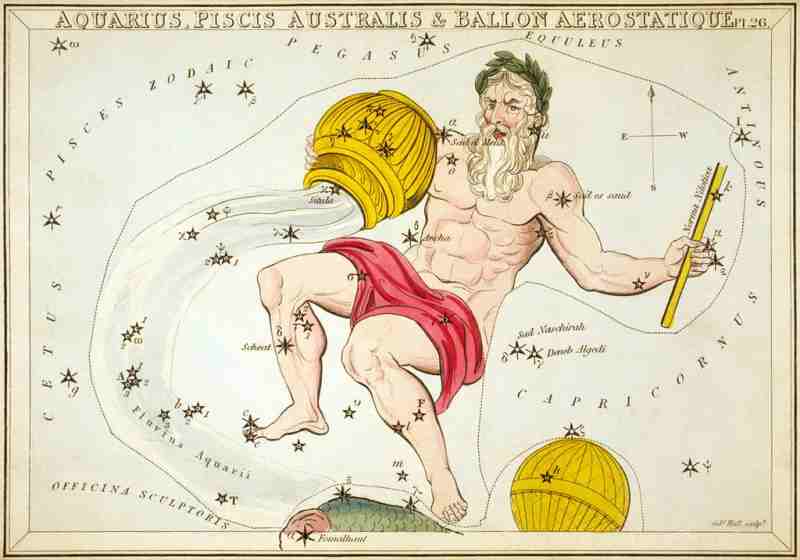 Water Jar The common Western depiction of Aquarius. His water jar, an asterism itself, consists of
γ, π, η, and ζ Aquarii; it pours water in a stream of more than 20 stars terminating with Fomalhaut which is actually in
the constellation of Piscis Austrinus.
Water Jar The common Western depiction of Aquarius. His water jar, an asterism itself, consists of
γ, π, η, and ζ Aquarii; it pours water in a stream of more than 20 stars terminating with Fomalhaut which is actually in
the constellation of Piscis Austrinus.
Circlet of Pisces This asterism is located south of Pegasus in the western fish of Pisces. It is formed by the stars γ, κ, λ, ι, and θ Piscium.
Job's Coffin Formed by the four brightest stars of the constellation Delphinus, it is about a 45° diamond consisting of α, β, γ, and δ Dephini. Due to it's small size and relatively faint stars, this asterism is really a better binocular object than naked-eye. If you include ε Delphini (the star at the lower right), it can be alternatively viewed as the Mini Kite.
 The diagram shows the upper southern sky as seen in late summer / early fall during the early evening.
The diagram shows the upper southern sky as seen in late summer / early fall during the early evening.
Great Square of Pegasus Formed by α, β, and γ Pegasi, with the final star α Andromedae. The big reasons it's so recognizable is the the square is well formed and there are relatively few naked-eye stars within the square.
Little Cassiopeia Sometimes called the Mini "W". Due it's small size and relatively faint stars, this asterism is really a better binocular object than naked-eye.
"W" This is basically the constellation of Cassiopeia. In the position we're showing it you can see that it is a W. However, when the constellation is above the North Star it looks like an M. So it can named either way, but it is almost always referred to as W.
Northern Cross This asterism follows closely with the constellation Cygnus (The Swan). It is called "Northern" because there is a constellation in the southern hemisphere called Crux, whose major stars form the Southern Cross which is depicted on the flags of Australia and New Zealand.
Job's Coffin Formed by the four brightest stars of the constellation Delphinus, it is about a 45° diamond consisting of α, β, γ, and δ Dephini. Due to it's small size and relatively faint stars, this asterism is really a better binocular object than naked-eye. If you include ε Delphini (the star at the lower right), it can be alternatively viewed as the Mini Kite.
The Winter Hexagon is the largest asterism in the entire sky. It is comprised of the bright stars: Sirius, Procyon, Pollux/Castor, Capella, Aldebaran, and Rigel. It is sometimes called the Winter Circle or the Football.
Click/Tap here to go to our Binocular Asterisms page.

